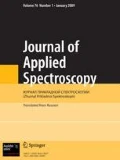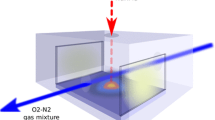The effects of the interpulse interval and the number of double laser pulses on the component and charge composition of the laser plasma formed intentionally by these pulses acting on an AD1 aluminum alloy target (LSS-1 spectrometer) were studied. It was shown that the concentration of Al ions and the products of their interaction with atmospheric oxygen and nitrogen increased by several orders of magnitude if an interpulse interval of 7–16 μs rather than a zero interval was used. The AlO suboxide and AlN molecule band intensities were highest for 40–50 sequential double pulses in a series and decreased if the number of pulses in a series increased because of poorer interaction of Al atoms and ions with air molecules and atoms at the outlet from the micronozzle as the microchannel depth and shape changed. The temperature in the region of plasma with the maximum content of Al III was estimated at ~22,000–30,000 K. The intensity ratio of AlO bands at 486.9/484.12 nm was used to determine the temperature in the AlO formation region. An expression was obtained for determining the temperature of the region corresponding to the maxima of AlO formation. The established temperature range of 4700–7000 K was slightly higher than the optimal AlO dissociation temperature (4400 K). A closed glass cell containing an Al target was used to obtain Al aerosols and products formed during interaction of Al ions with atmospheric oxygen and nitrogen. The size of Al2O3 primary particles obtained at a pulse energy of 53 mJ was estimated as 30–40 nm using high-resolution electron microscopy. The particles were assembled into agglomerates. The possibility of practical production of activated Al2O3 nanopowders by irradiating a target with successive series of 50 double pulses per point for 10 min in a closed bottle was considered. Raman spectroscopy was used to show that active forms of aluminum oxides and their interaction products with atmospheric oxygen and nitrogen in a laser plasma could be deposited on a glass surface in a closed cell.
Similar content being viewed by others
References
A. P. Il′in, O. B. Nazarenko, A. V. Korshunov, and L. O. Root, Features of the Physicochemical Properties of Nanopowders and Nanomaterials [in Russian], Izd. Tomsk. Politekh. Univ., Tomsk (2012), pp. 12–15.
A. A. Gromov, T. A. Khabas, and A. P. Il′in, in: Burning of Metal Nanopowders [in Russian], A. A. Gromov (ed.), Izd. Tomsk. Politekh. Univ., Tomsk (2008), pp. 87–97.
A. I. Gusev, Nanomaterials, Nanostructures, Nanotechnologies [in Russian], Fizmatlit, Moscow (2005), pp. 41–66.
S. A. Solov′ev and S. N. Orlik, Kinet. Katal., 50, No. 5, 734–744 (2009).
V. N. Troitskii, V. M. Batenin, I. I. Klimovskii, and G. V. Lysov, RF Generators of Plasma. Physics, Technology, Application [in Russian], Energoatomizdat, Moscow (1988), pp. 175–221.
L. S. Polak, A. A. Ovsyannikov, D. I. Slovetskii, and F. B. Vurzel′, Theoretical and Applied Plasma Chemistry [in Russian], Nauka, Moscow (1975), pp. 222–282.
S. N. Kul′kov and S. P Buyakova, Ross. Nanotekhnol., 2, Nos. 1–2, 119–132 (2007).
Kh. Bazzal, A. R. Fadaiyan, and A. P. Zazhogin, Zh. Belgosuniv., Fiz., No. 1, 34–42 (2017).
V. S. Buryakov, A. F. Bokhanov, M. I. Nedel′ko, and N. V. Tarasenko, Kvantovaya Elektron. (Moscow), 33, No. 12, 1065–1071 (2003).
Kh. Bazzal, E. S. Voropai, A. P. Zazhogin, and M. P. Patapovich, in: Interinstitutional Collection of Scientifi c Works "Physicochemical Aspects of Studying Clusters, Nanostructures and Nanomaterials" [in Russian], No. 11, Tver′ (2019), pp. 48–56.
Kh. Bazzal, N. A. Alekseenko, E. S. Voropai, M. N. Kovalenko, M. P. Patapovich, and A. P. Zazhogin, in: Interinstitutional Collection of Scientifi c Works "Physicochemical Aspects of Studying Clusters, Nanostructures and Nanomaterials" [in Russian], No. 12, Tver′ (2020), pp. 516–525.
V. M. Samsonov and N. Yu. Sdobnyakov, Poverkhn.: Rentgenovskie Sinkhrotronnye Neitr. Issled., No. 2, 73–78 (2004).
N. Yu. Sdobnyakov, V. M. Samsonov, and A. N. Bazulev, Vestn. Novgorod. Gos. Univ. im. Yaroslava Mudrogo, Ser. Tekh. Nauki, No. 5 (103), 43–48 (2017).
M. P. Anisimov, Usp. Khim., 72, No. 7, 664–705 (2003).
M. A. Korepanov, S. A. Gruzd′, and A. A. Chukavina, Khim. Fiz. Mezoskopiya, 21, No. 2, 218–226 (2019).
N. A. Romanov, A. V. Nomoev, and S. V. Kalashnikov, Vestn. Buryat. Gos. Univ., No. 3, 93–99 (2013).
S. M. Garnov, V. I. Klimentov, T. V. Konov, S. V. Kononenko, and F. Dausinger, Kvantovaya Elektron. (Moscow), 25, No. 1, 45–48 (1998).
S. M. Klimentov, S. V. Garnov, V. I. Konov, and T. V. Kononenko, Tr. Inst. Obshch. Fiz. im. A. M. Prokhorova, Ross. Akad. Nauk, 60, 13–29 (2004).
I. A. Bufetov, S. B. Kravtsov, and V. B. Fedorov, Kvantovaya Elektron. (Moscow), 23, No. 5, 535–540 (1996).
G. E. Belyaev, A. M. Velichko, V. P. Dubenkov, M. N. Larichev, A. I. Nikitin, A. E. Sheindlin, E. I. Shkol′nikov, and I. V. Yanilkin, Teplofi z. Vys. Temp., 50, No. 6, 804–809 (2012).
Author information
Authors and Affiliations
Corresponding author
Additional information
Translated from Zhurnal Prikladnoi Spektroskopii, Vol. 88, No. 2, pp. 211–220, March–April, 2021.
Rights and permissions
About this article
Cite this article
Bazzal, K., Alekseenko, N.A., Voropay, E.S. et al. Formation of Al2O3 and AIN Nanopowders by Exposing Aluminum to a Series of Double Laser Pulses in Air. J Appl Spectrosc 88, 274–282 (2021). https://doi.org/10.1007/s10812-021-01169-5
Received:
Published:
Issue Date:
DOI: https://doi.org/10.1007/s10812-021-01169-5



